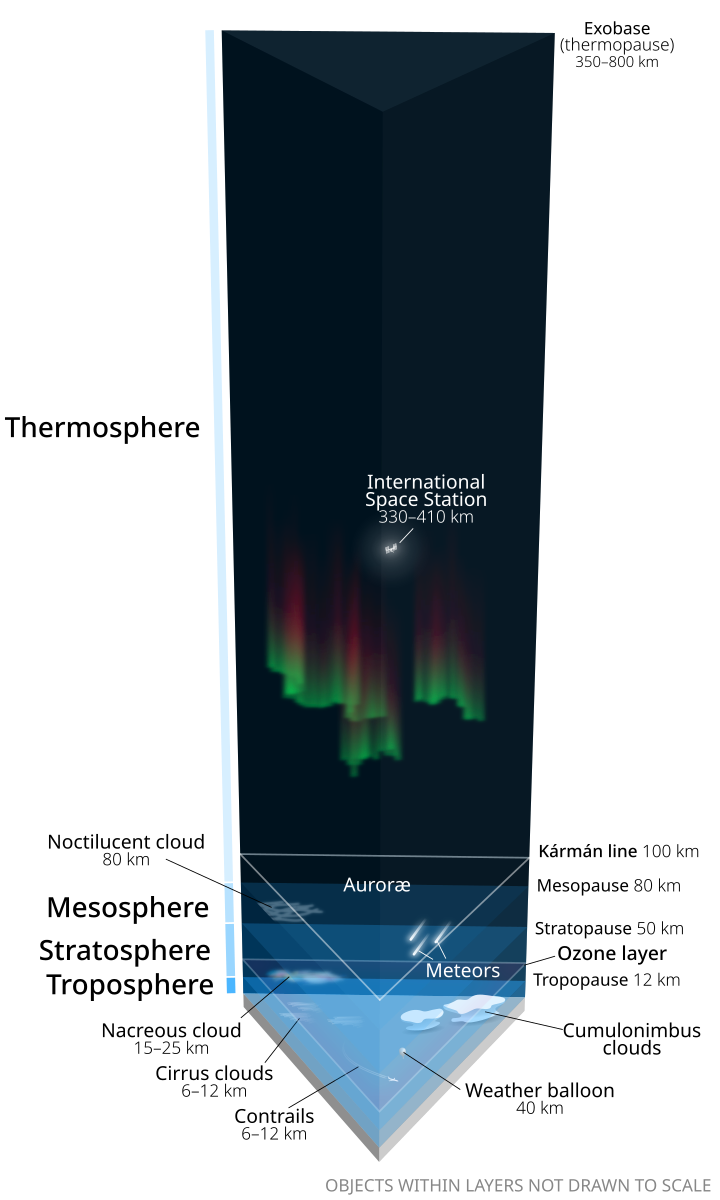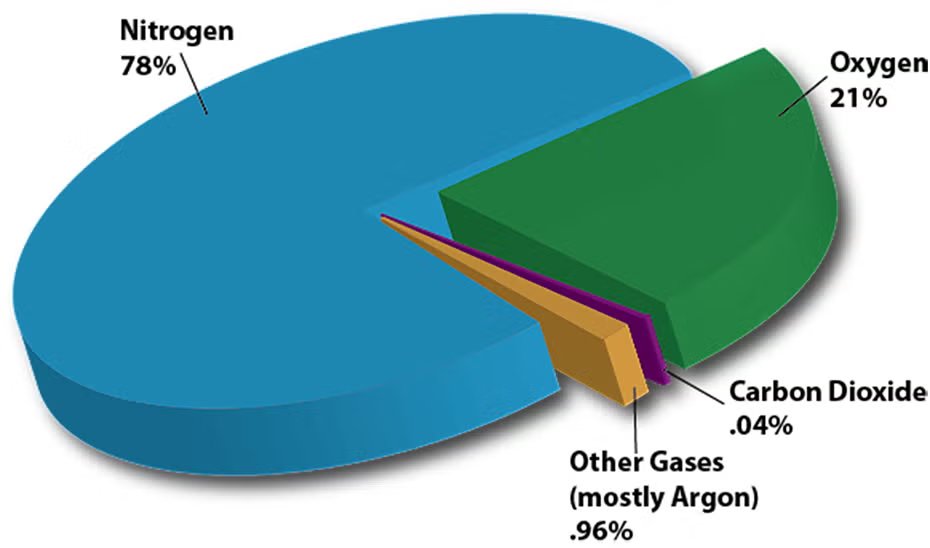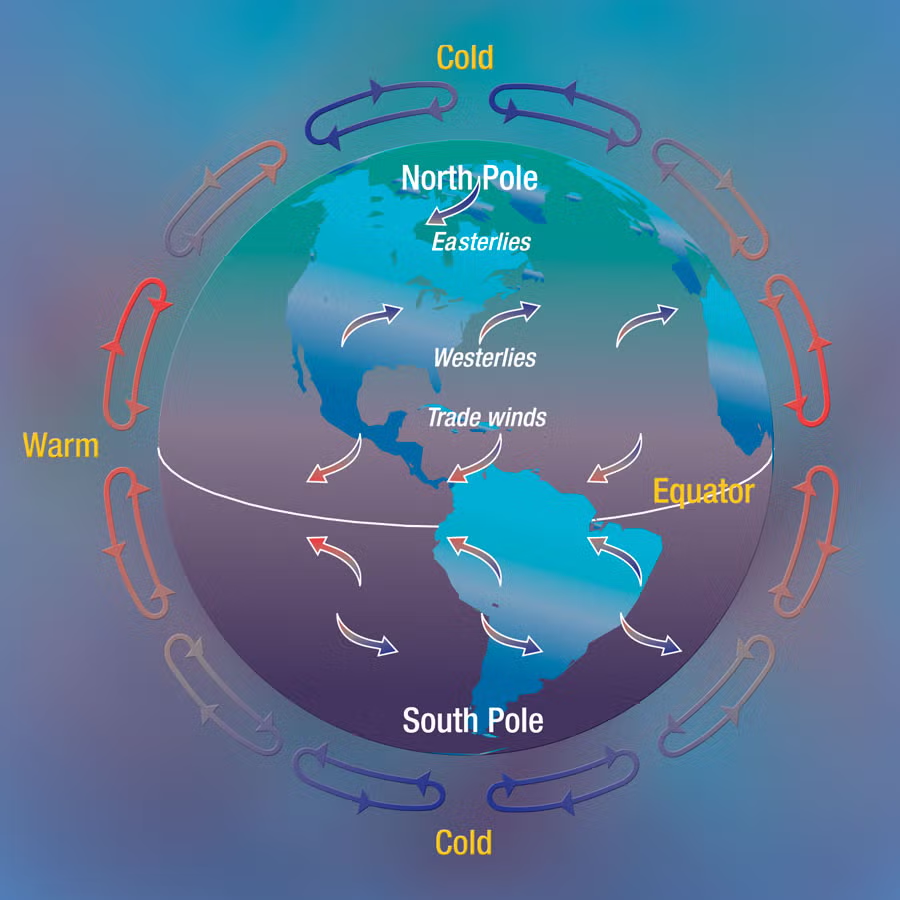IB Syllabus focus:
‘Atmosphere marks Earth’s outer biosphere boundary; gas composition and physical processes (e.g., winds) sustain life and redistribute gases.’
The atmosphere is vital for sustaining life on Earth, acting as a protective layer, regulating temperature, cycling gases, and supporting biological and physical processes that maintain environmental balance.
Structure and Composition of the Atmosphere
The atmosphere extends from Earth’s surface into space, blending gradually until it merges with interplanetary space. Its structure plays an essential role in supporting life.

Labeled cross-section of Earth’s atmosphere showing the principal layers and key features such as the ozone layer and weather region. This visual supports how vertical structure underpins life support and protection functions. Minor additional details (e.g., aurora placement) extend beyond the syllabus but do not add complexity. Source.
Key Layers
Troposphere: The lowest layer, where weather occurs and where most life-supporting gases are concentrated.
Stratosphere: Contains the ozone layer, protecting organisms from harmful ultraviolet (UV) radiation.
Mesosphere and Thermosphere: Higher layers that interact with solar radiation and provide additional protective functions.
Composition of Atmospheric Gases
The atmosphere is made of a stable mix of gases that support biological and physical processes:
Nitrogen (N₂): ~78% – crucial for proteins and DNA.
Oxygen (O₂): ~21% – essential for respiration.
Argon (Ar): ~0.9% – inert but stabilising.
Carbon dioxide (CO₂): ~0.04% – vital for photosynthesis and regulating climate.
Trace gases include neon, helium, methane, and water vapour.

Pie chart of the dry atmosphere showing nitrogen ~78%, oxygen ~21%, argon ~0.9%, and carbon dioxide ~0.04%, with trace gases. This directly supports the composition figures referenced in the notes. Water vapour is variable and typically excluded from dry-air pies. Source.
Atmosphere: The layer of gases surrounding Earth, held in place by gravity, which supports life and redistributes heat and essential gases.
How the Atmosphere Supports Life
The atmosphere provides multiple critical functions for sustaining organisms and ecosystems.
Protection
Shields life from harmful UV radiation via the ozone layer.
Burns up many meteoroids before they reach Earth’s surface.
Temperature Regulation
Retains heat through the natural greenhouse effect, preventing extreme temperature fluctuations.
Ensures Earth remains within habitable limits for liquid water and living organisms.
Essential Gases for Biological Processes
Supplies oxygen for respiration.
Provides carbon dioxide for photosynthesis.
Contains nitrogen, which enters the nitrogen cycle for plant and animal nutrition.
Water Cycle
Water vapour in the atmosphere allows precipitation and regulates hydrological processes.
Distributes fresh water essential for all terrestrial ecosystems.
Redistribution of Gases
The atmosphere is dynamic, constantly moving gases through circulation and mixing processes.

Schematic of global atmospheric circulation showing prevailing wind belts and large-scale airflow that transport heat and gases. This directly supports the role of winds in gas redistribution. The depiction includes circulation structure that slightly overlaps later syllabus content but remains a concise, useful overview. Source.
Physical Processes
Winds redistribute heat and gases across the globe.
Turbulence and diffusion ensure gases like oxygen and carbon dioxide reach organisms everywhere.
Vertical Mixing
Convection currents in the troposphere mix gases, ensuring life-supporting substances are available across altitudes where organisms live.
Horizontal Transport
Jet streams and global winds move air masses across continents.
This reduces regional shortages of oxygen or carbon dioxide and balances the distribution of trace gases.
Role of Biogeochemical Cycles
The atmosphere is central to major cycles that sustain ecosystems.
Carbon Cycle
Carbon dioxide absorbed during photosynthesis and released during respiration and combustion.
Maintains balance in atmospheric CO₂ concentrations.
Nitrogen Cycle
Atmospheric nitrogen is fixed into usable forms by bacteria and lightning.
Returned to the atmosphere through denitrification, maintaining a reservoir for ecosystems.
Oxygen Cycle
Oxygen is continually cycled through respiration, combustion, and photosynthesis, sustaining aerobic life.
Biogeochemical cycles: Natural pathways by which essential elements (e.g., carbon, nitrogen, oxygen) are exchanged between the atmosphere, lithosphere, hydrosphere, and biosphere.
The Atmosphere as Earth’s Outer Biosphere Boundary
The atmosphere represents the outer boundary of Earth’s biosphere. Without it:
There would be no breathable oxygen or protective ozone.
Gas exchange necessary for photosynthesis and respiration would not occur.
Liquid water would evaporate or freeze without pressure and temperature regulation.
This boundary is essential for maintaining Earth’s habitability and distinguishes Earth from other planets lacking similar atmospheric conditions.
Summary of Processes that Support Life and Redistribute Gases
Life support functions: Protection, temperature regulation, provision of gases, water cycle.
Redistribution processes: Winds, turbulence, jet streams, convection.
Cycle integration: Oxygen, carbon, and nitrogen cycles.
Boundary role: Defines the biosphere’s limit and maintains habitability.
FAQ
Earth’s atmosphere is uniquely balanced with nitrogen, oxygen, and trace gases in proportions that sustain complex life.
Other planets often lack this balance:
Mars has a thin, mostly carbon dioxide atmosphere, insufficient for respiration and temperature regulation.
Venus has a dense CO₂ atmosphere causing extreme greenhouse warming.
This combination of composition, pressure, and protective functions makes Earth’s atmosphere distinct in its ability to support diverse ecosystems.
Atmospheric pressure ensures liquid water can exist on Earth’s surface. Without it, water would either boil away or freeze, making life impossible.
It also allows gases such as oxygen and carbon dioxide to dissolve effectively in water, enabling aquatic organisms to respire.
Furthermore, pressure regulates altitude-based oxygen availability, influencing how plants and animals adapt in highland and lowland regions.
Water vapour is a dynamic component of the atmosphere, varying with temperature and location.
It contributes by:
Driving convection currents that transport heat and other gases.
Acting as a greenhouse gas, regulating energy balance.
Enabling precipitation, which redistributes dissolved gases such as oxygen and carbon dioxide in aquatic systems.
This variability ensures the water cycle links atmospheric redistribution to terrestrial and aquatic life support.
Turbulence mixes gases locally, often over short distances, caused by obstacles like mountains or urban landscapes.
Large-scale winds, such as trade winds and jet streams, transport gases across continents and oceans.
Together, turbulence ensures even local distribution, while large-scale winds balance global patterns of oxygen, carbon dioxide, and trace gases, ensuring consistent availability for ecosystems worldwide.
Even small changes can destabilise life-supporting systems.
A decline in oxygen levels would limit respiration for animals and humans.
An increase in carbon dioxide beyond natural levels could intensify climate impacts, affecting photosynthesis and ecosystems unevenly.
Reduced nitrogen would disrupt soil fertility and crop growth.
Such imbalances highlight how finely tuned Earth’s atmosphere is to sustaining life and redistributing gases effectively.
Practice Questions
Question 1 (2 marks)
State two ways in which the atmosphere supports life on Earth.
Mark Scheme
1 mark for each correct way stated, up to 2 marks.
Examples:Provides oxygen for respiration.
Contains carbon dioxide for photosynthesis.
Shields organisms from harmful ultraviolet (UV) radiation.
Regulates temperature through the natural greenhouse effect.
Maintains the water cycle via atmospheric water vapour.
Question 2 (5 marks)
Explain how the composition and physical processes of the atmosphere help redistribute gases and support life on Earth.
Mark Scheme
Award up to 5 marks for the following points, with clear, well-linked explanations:
1 mark: Identification of the main gases in the atmosphere (e.g., nitrogen, oxygen, carbon dioxide).
1 mark: Explanation of how these gases are essential to biological processes (e.g., nitrogen for proteins, oxygen for respiration, carbon dioxide for photosynthesis).
1 mark: Description of physical processes such as winds, turbulence, or convection that mix and move gases.
1 mark: Explanation of horizontal or vertical redistribution of gases (e.g., jet streams moving air masses, convection currents in the troposphere).
1 mark: Linking redistribution to sustaining life globally (ensuring availability of gases across different regions and ecosystems).

